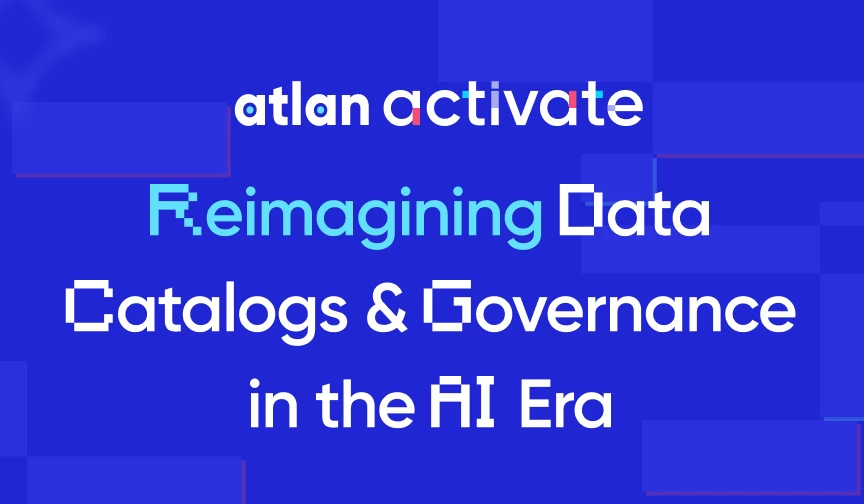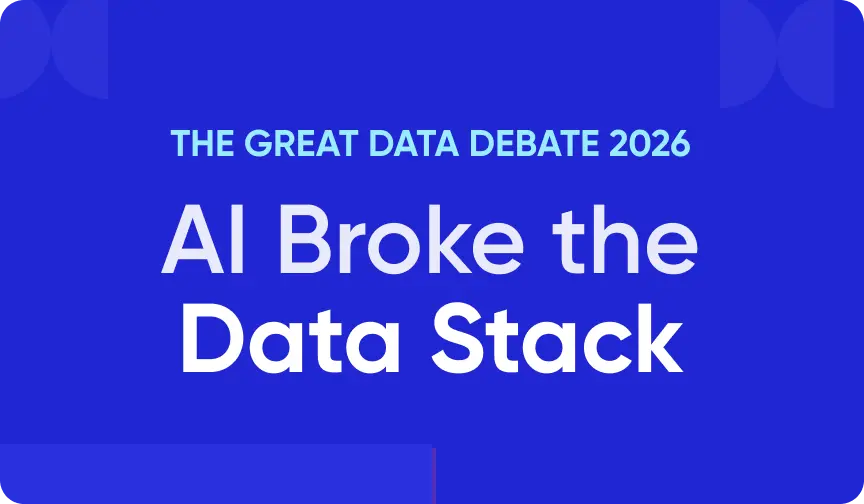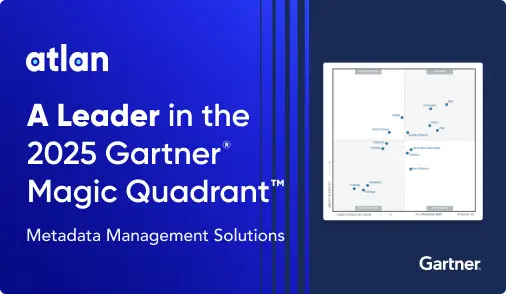Data Policy Enforcement Tools: Must-Have Product Capabilities in 2025

Last Updated on: April 07th, 2025 | 7 min read
Unlock Your Data's Potential With Atlan

Data policy enforcement tools ensure that data governance policies are implemented effectively across data and analytics assets. According to Gartner, these tools ‘operationalize, serve and automate the work of the data and analytics steward (business role) in policy enforcement.’
This article explores data policy enforcement requirements and the essential capabilities to consider while evaluating modern data governance tools.
Table of Contents
Permalink to “Table of Contents”- Data policy enforcement tools: An overview
- Data policy enforcement tools: Four must-have product capabilities
- A transparent policy center
- Enforcement analytics
- Advanced audit trails
- Open API architecture and endless extensibility
- Data policy enforcement tools: How Atlan’s metadata control plane offers a holistic approach
- Wrapping up
- FAQs about data policy enforcement tools
Data policy enforcement tools: An overview
Permalink to “Data policy enforcement tools: An overview”Data policy enforcement tools help you interpret your data governance policies, ensuring compliance with the rules and standards outlined by your data governance program.
Effective policy enforcement ensures compliance by monitoring data usage, maintaining consistency in data formats, and evaluating business impact of governance efforts.
Data policy enforcement tools also facilitate quality assurance through key data metrics, anomaly detection, incident response, and resolving policy exceptions.
Data policy enforcement tools: Four must-have product capabilities
Permalink to “Data policy enforcement tools: Four must-have product capabilities”Data policy enforcement is a part of a broader data, analytics, and AI governance program. As such, an effective data policy enforcement tool should be built on the principles of automation and AI, openness and extensibility, personalization, and a unified control plane.
Core capabilities of such a tool should include:
- A transparent policy center: A single pane of glass for monitoring and enforcing policies across your data estate
- Enforcement analytics: Actionable insights to measure the effectiveness of governance policies
- Audit trails: A complete, traceable record of policy changes, requests, asset modifications, and more over time
- Open API architecture: Flexibility to integrate with any data stack and adapt to evolving governance needs
Let’s explore each of these capabilities further.
A transparent policy center
Permalink to “A transparent policy center”A transparent policy center offers a top-down view of policy coverage across your data estate. You get a holistic view of the full range of your D&A governance policies, allowing you to track compliance, assess policy coverage, and resolve governance gaps.
With this single pane of glass for policy enforcement, you can:
- Observe all data governance policies at a glance and see how your data assets are being governed over time
- Filter policies by type and scope to assess compliance coverage
- Identify overlapping policies and evaluate potential conflicts
- Detect and review non-compliant or ungoverned data assets
- Automate incident reporting and notify the respective policy owners via their preferred tools (with embedded collaboration)
- Manage approval workflows for new or expiring policies
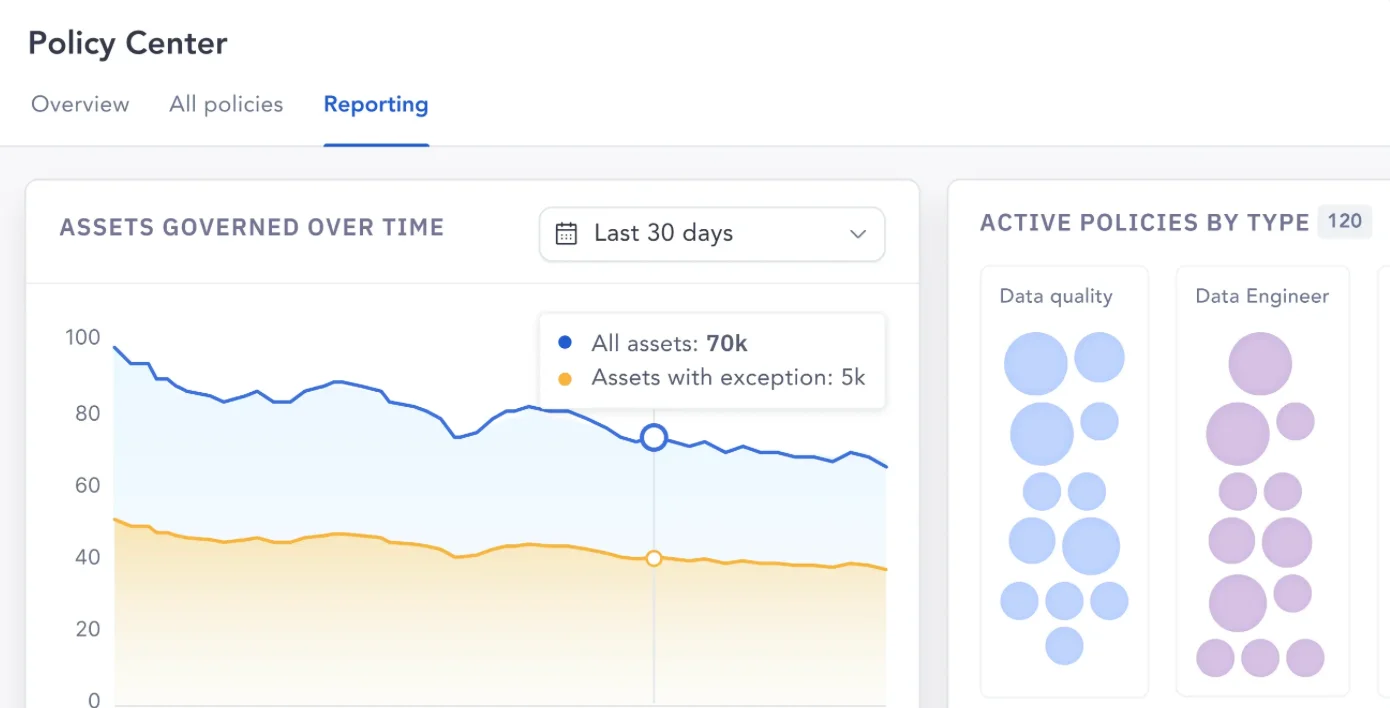
An example of a transparent policy center to support data policy enforcement across your data estate - Image by Atlan.
Enforcement analytics
Permalink to “Enforcement analytics”Measuring the effectiveness of data governance policy enforcement involves monitoring key metrics such as compliance rates, policy violations, incident resolution time, and adoption by users.
To monitor and measure these metrics, the data policy enforcement tool you adopt should provide granular insight into the impact of your data governance policies on business operations and governance workflows.
So, look for a data policy enforcement tool that provides:
- Real-time monitoring of query access and user permissions
- Insights into active data governance policies
- Automated metadata propagation tracking through lineage
- Completeness checks by analyzing metadata attributes (descriptions, tags, owners, etc.)
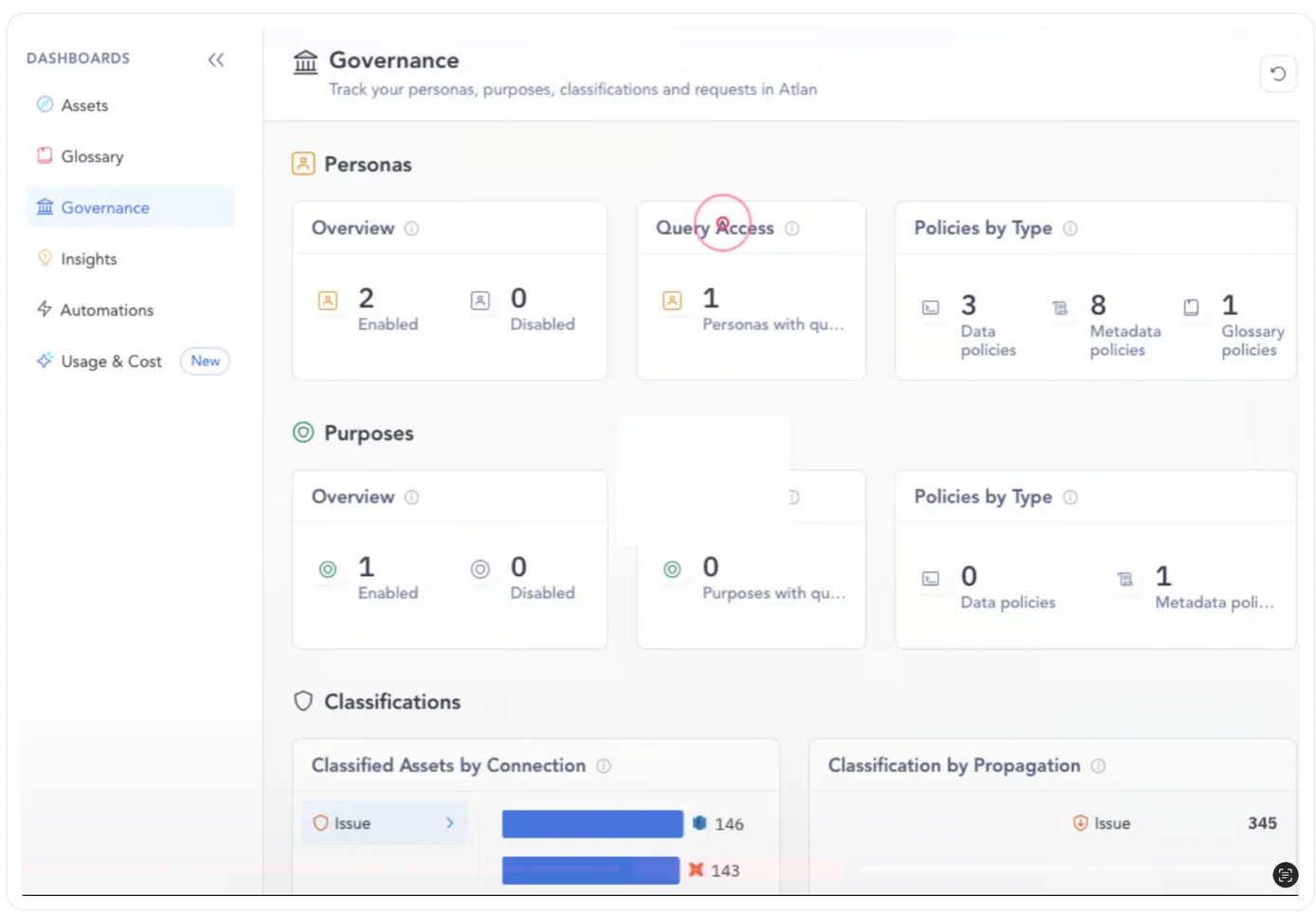
An example of enforcement analytics at a glance in a data policy enforcement tool - Image by Atlan.
Advanced audit trails
Permalink to “Advanced audit trails”Audit trails play a crucial role in policy enforcement by capturing every policy change, access request, and data asset modification. This ensures traceability, transparency, and accountability in governance workflows.
Look for a data policy enforcement tool that:
- Maintain a historical record of all activity related to a specific asset—including updates, workflow interactions, and policy changes
- Track asset modifications and governance actions in real time
- Provide version history, similar to logs in Google Docs or Notion, to review all activities related to an asset
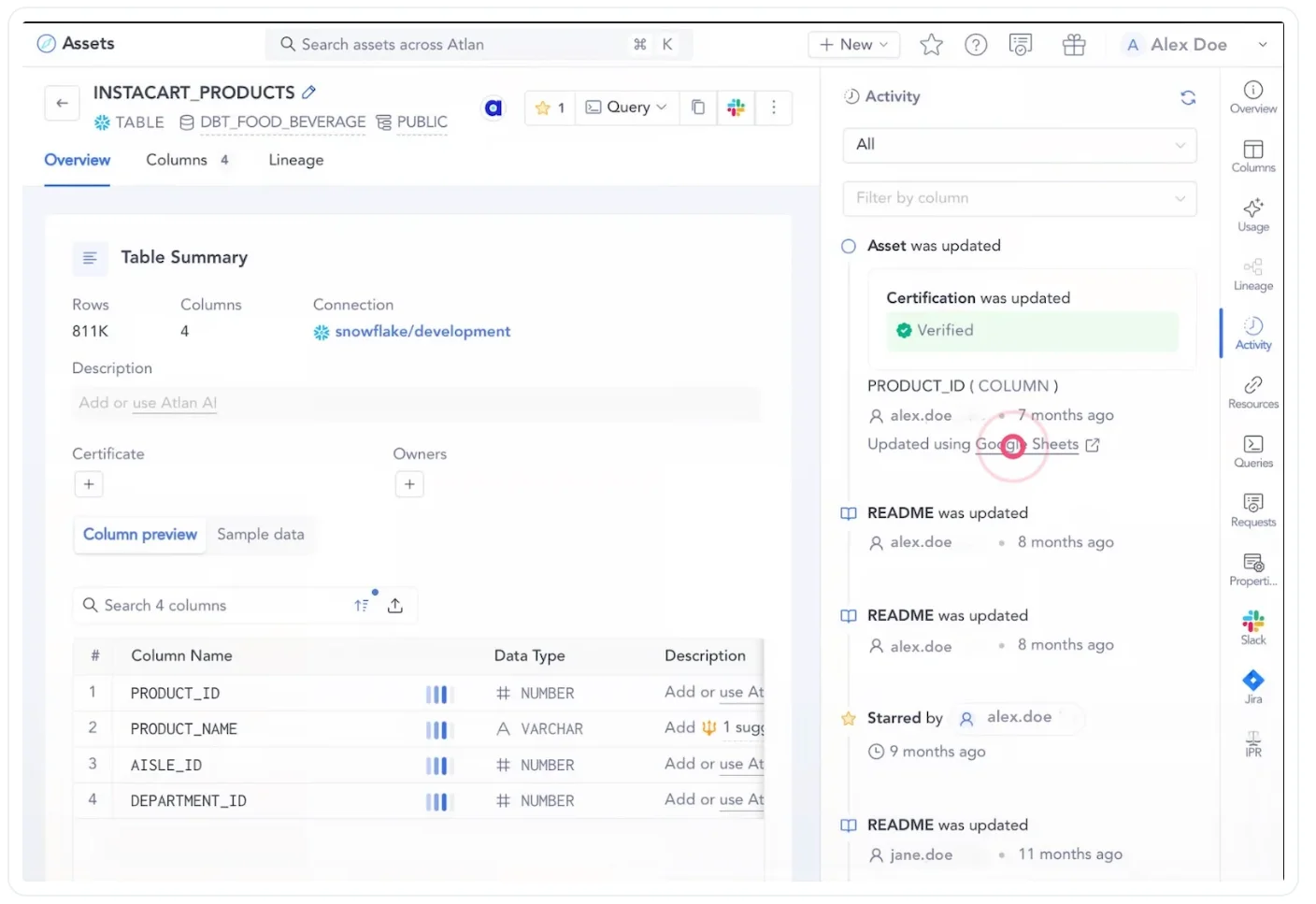
An example of audit trails weaved into data asset profiles - Image by Atlan.
Open API architecture and endless extensibility
Permalink to “Open API architecture and endless extensibility”An open API architecture ensures your data governance framework remains adaptable to evolving technologies and diverse use cases. It enables seamless integration with existing systems, allowing organizations to build custom connectors, automate alerts, and streamline workflows.
A truly extensible data policy enforcement tool should offer a self-service layer that standardizes and automates policy enforcement across your entire data estate. This ensures flexibility, scalability, and future-proof governance tailored to your organization’s needs.

An endlessly open and extensible data policy enforcement tool can integrate with numerous tools via open APIs - Image by Atlan.
Data policy enforcement tools: How Atlan’s metadata control plane offers a holistic approach
Permalink to “Data policy enforcement tools: How Atlan’s metadata control plane offers a holistic approach”Atlan’s data and AI governance platform, powered by active metadata, offers scalable, automated, and future-ready policy setting and enforcement with:
- A unified policy center that links your data governance policies to data assets
- Rule-based automation for real-time policy enforcement and compliance tracking
- Advanced audit trails maintaining detailed records of policy changes, access requests, and data asset modifications for transparency and accountability
- Real-time incident alerts prevent governance lapses before they become major issues
- An open, extensible metadata lakehouse infrastructure to manage increasing data scale and complexity
By embedding automation and AI into governance processes, Atlan ensures that enterprises can enforce policies effectively while reducing compliance risks and governance overhead.
Wrapping up
Permalink to “Wrapping up”Data policy enforcement tools help organizations implement governance policies, ensuring compliance, security, and operational efficiency. AI, automation, and open APIs enable proactive enforcement at scale, while advanced audit trails maintain governance transparency.
A metadata control plane like Atlan simplifies policy enforcement, ensuring that governance keeps pace with evolving regulatory and business needs.
FAQs about data policy enforcement tools
Permalink to “FAQs about data policy enforcement tools”What is a data policy enforcement tool and how does it work?
Permalink to “What is a data policy enforcement tool and how does it work?”A data policy enforcement tool helps organizations implement and monitor data governance policies across their entire data estate. These tools interpret governance rules and automate enforcement using AI and metadata. They ensure compliance, detect policy exceptions, and streamline governance through centralized dashboards, analytics, and real-time incident alerts.
What are the must-have capabilities of a modern data policy enforcement tool in 2025?
Permalink to “What are the must-have capabilities of a modern data policy enforcement tool in 2025?”In 2025, top data policy enforcement tools must offer:
- A transparent policy center for real-time policy visibility
- Enforcement analytics to measure policy impact and compliance rates
- Advanced audit trails to ensure traceability and accountability
- Open API architecture for seamless integration and extensibility
These capabilities enable scalable, automated governance in evolving data environments.
How do policy centers improve data governance enforcement?
Permalink to “How do policy centers improve data governance enforcement?”A transparent policy center provides a single-pane-of-glass view of all governance policies. It helps data teams track compliance, identify non-compliant assets, resolve policy conflicts, and manage workflows. By centralizing policy visibility and collaboration, it improves enforcement efficiency and ensures consistent governance across the data estate.
Why is enforcement analytics important in data governance?
Permalink to “Why is enforcement analytics important in data governance?”Enforcement analytics helps organizations assess the effectiveness of their governance policies. These tools track metrics like policy adoption, violation frequency, and resolution time. With real-time insights into policy impact and data usage, teams can proactively improve governance and ensure regulatory compliance.
Can data policy enforcement tools integrate with existing data stacks?
Permalink to “Can data policy enforcement tools integrate with existing data stacks?”Yes, modern data policy enforcement tools offer open API architectures that integrate with various data platforms, catalogs, and BI tools. This ensures organizations can extend policy coverage, automate workflows, and adapt governance strategies to evolving technologies and business needs.
Share this article
Atlan is the next-generation platform for data and AI governance. It is a control plane that stitches together a business's disparate data infrastructure, cataloging and enriching data with business context and security.
Data policy enforcement tools: Related reads
Permalink to “Data policy enforcement tools: Related reads”- What is Data Governance? Its Importance, Principles & How to Get Started?
- Data Governance Framework: Examples, Templates, Standards, Best Practices & How to Create One?
- Key Objectives of Data Governance: How Should You Think About Them?
- Data Governance Strategy: How To Get Started?
- How to Implement Data Governance: Steps, Prerequisites, Essential Factors & Business Case
- How to Improve Data Governance: Steps, Tips & Template
- 7 Steps to Simplify Data Governance for Your Entire Organization
- Automated Data Governance: How Does It Help You Manage Access, Security & More at Scale?
- Enterprise Data Governance Basics, Strategy, Key Challenges, Benefits & Best Practices
- Data Governance and Compliance: An Act of Checks & Balances
- Data Compliance Management in 2025
- Data Governance and GDPR: A Comprehensive Guide to Achieving Regulatory Compliance
- Data Governance in Banking: Benefits, Challenges, Capabilities
- Financial Data Governance: Strategies, Trends, Best Practices
- BCBS 239 Data Governance: What Banks Need to Know in 2025
- Data Governance & Business Intelligence: Why Their Integration Matters and How It is Crucial for Business Success?
- Unified Control Plane for Data: The Future of Data Cataloging
- Data Governance Policy: A Complete Guide with Examples & Templates
- Data Governance Policy Enforcement: Definition, Tools, Steps

